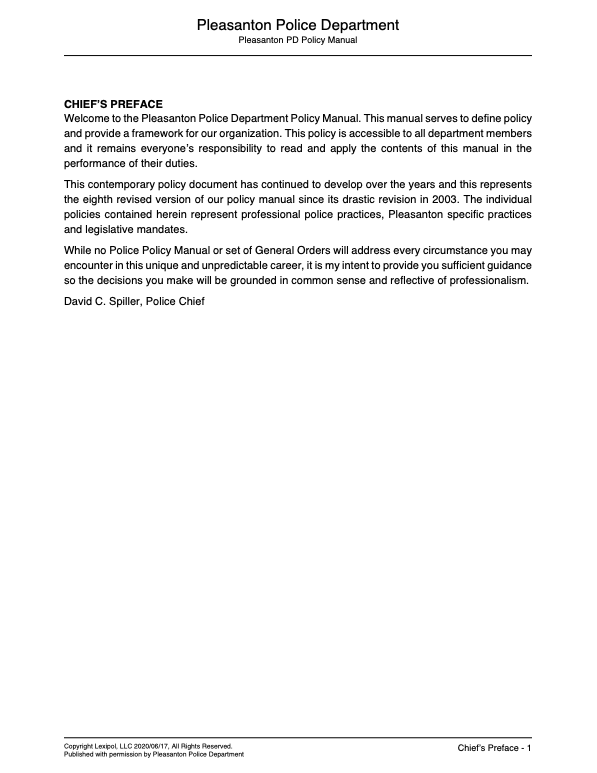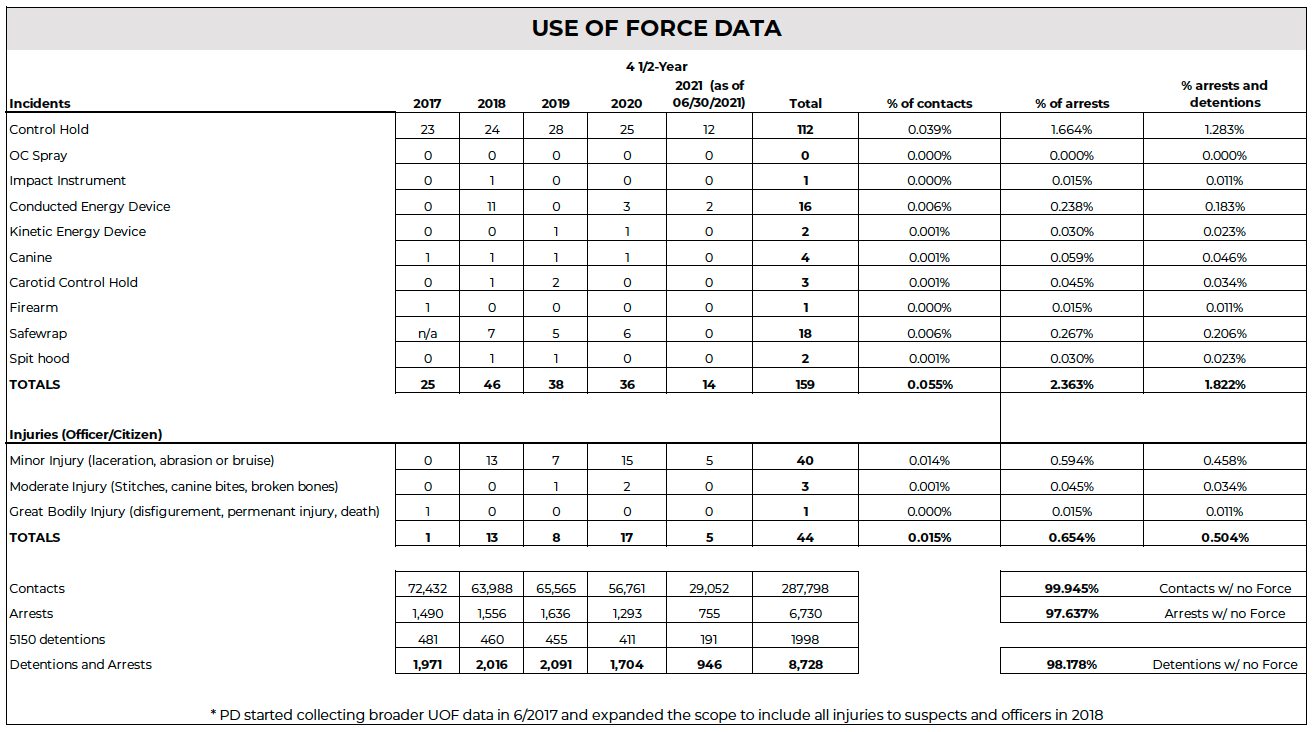Department Policies
Understanding Pleasanton Police Department’s Policies
The Pleasanton Police Department created this comprehensive resource detailing our current policies in response to the community’s interest in how and when officers are permitted to use force. We believe our current policies meet the proposed restrictions and underscores our efforts to minimize the use of force.
Use of Force Policies
Chokeholds
Chokeholds and strangleholds are control techniques, which restrict the airway by compressing the trachea. These holds have been banned by nearly all police departments since the 1990s. Controversially categorized as a chokehold is the carotid restraint which applies pressure to the carotid artery to briefly incapacitate suspects without affecting their ability to breathe.
On June 5, 2020, California’s Commission on Peace Officer Standards and Training (POST) decertified the carotid restraint and ceased its instruction in police academies. Within days, the Pleasanton Police Department suspended use of the carotid restraint and amended its policy to state: “The carotid restraint control hold is not authorized.”
At its August 20, 2020, meeting the City Council recommended no change to this policy at this time.
Shooting at Moving Vehicles
This policy and related department training emphasize that shooting at moving vehicles is not effective. In many cases where an officer fires at a moving vehicle, it is because the vehicle is being driven at the officer or another officer. Targeting the driver of a moving vehicle is difficult and, in these cases, it is almost always more effective to move out of the vehicle’s path.
However, the policy should not prohibit the use of lethal force against the driver or occupant of a moving vehicle. If shooting at moving vehicles was entirely prohibited, a suspect could fire indiscriminately at officers, individuals or crowds without fear of intervention by the police.
At its August 20, 2020, meeting the City Council recommended no change to this policy at this time.
De-escalation Training and Practice
An emphasis on de-escalation training and use is considered best practice in modern law enforcement. The Pleasanton Police Department and most California law enforcement agencies have focused their attention toward de-escalating situations whenever possible. This is especially true with situations involving individuals experiencing acute mental health crises. The police department requires newly hired officers attend a 40-hour Crisis Intervention Training (CIT) course as soon as possible. Principles of de-escalation are also woven into other components of the department’s training program.
De-escalation is recommended throughout the policy in situations where it can be employed. In some cases, de-escalation can mean removing police from the scene altogether, which occurs in situations where someone is alone threatening suicide or certain misdemeanor crimes where no threat of violence to others exists.
At its August 20, 2020, meeting the City Council recommended that language be added to the police policy manual requiring officers consider and utilize alternative tactics / de-escalation techniques when feasible, and when doing so will not reasonably compromise the safety of the officers or the community.
Exhaust All Alternatives Before Using Force
A policy requiring the exhaustion of all alternatives regardless of feasibility or possible effectiveness before using force is unrealistic and dangerous. Time is an important factor and some situations do not afford officers the opportunity to exhaust all alternatives. If a person poses an immediate threat to the safety of others, officers must act rapidly. This is done to minimize risk to the public, officers and to the person posing the threat. A requirement to exhaust all alternatives would put the officers and public at increased risk; as affirmed by the U.S. Supreme Court an officer’s decision to use force is based on a reasonable officer standard without the benefit of 20/20 hindsight.
At its August 20, 2020, meeting the City Council recommended that language be added to the police policy manual which encourages officers to utilize reasonably available alternative tactics which may persuade an individual to voluntarily mitigate the need to use force.
Require Warning Before Shooting
Pleasanton Police Department’s policy requires, when reasonable, a verbal warning with an opportunity to comply prior to the use of force. Additionally Pleasanton Police Policy Manual section 300.4 states, “Where feasible, the officer shall, prior to the use of force, make reasonable efforts to identify themselves as a peace officer and to warn that deadly force may be used, unless the officer has objectively reasonable grounds to believe the person is aware of those facts.”
At its August 20, 2020, meeting the City Council recommended applying the warning requirement for shooting at fleeing suspects to all deadly force applications.
Comprehensive Reporting
The police department has both policy and established procedures to review, document and track use of force incidents regardless of severity. Policy manual section 300.5 requires the documentation of all use of force by officers and a broad list of qualifications which require immediate notice be made to a supervisor.
A use of force notification form is completed by the supervisor. The form lists seven criteria in which a more comprehensive administrative review is required. All forms and any additional documentation are forwarded to the unit manager for a second review and then are forwarded to the division commander for a third level of review. Following this, the form is submitted to the force options training manager for a review specifically for training needs or deficiencies. The form is then forwarded to the professional standards unit supervisor who collects statistical data from the incident and tracks the use of force. Finally, the entire review is forwarded to the Chief of Police for final review.
At its August 20, 2020, meeting the City Council recommended that language be added to the police policy manual requiring officers consider and utilize alternative tactics / de-escalation techniques when feasible, and when doing so will not reasonably compromise the safety of the officers or the community, as well as implementing a use of force tracking and early warning system.
Duty to Intercede
Pleasanton Police Department’s policy clearly states that any officer present and observing another officer using force beyond that which is objectively reasonable under the circumstances shall, when in a position to do so, intercede to prevent the use of unreasonable force. An officer who observes another employee using force that exceeds the degree of force permitted by law should promptly report these observations to a supervisor. This requirement is consistent with federal case law, state law, and is recognized as a moral obligation in the Pleasanton Police Department.
At its August 20, 2020, meeting the City Council recommended the addition of a new police department requirement to report excessive use of force to supervisor following incident.
Use of Force Continuum
Use of force decisions are made instantly based on facts and circumstances known to the officer at the time. A use of force continuum has theoretical value, but it is dangerous to create a policy that requires a specific order of escalation of force, because the possibility of situations in which decisions must be made is endless. Pleasanton police officers are trained to use an appropriate level of force based on it being objectively reasonable considering the totality of the circumstances.
At its August 20, 2020, meeting the City Council recommended no changes to this policy.
Our Encounters and Use of Force
The Pleasanton Police Department collects data on all encounters to ensure officers are following policy, specifically body worn camera activations and use of force. The California Department of Justice also requires law enforcement agencies to report incidents of force where serious injuries were sustained or a firearm was discharged. These numbers reflect our community interactions from 2017-2019.
%
Contacts Where No Force Was Used
%


